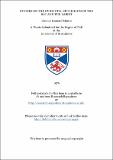Files in this item
Studies on the oviductal epithelium of the rat and the rabbit
Item metadata
| dc.contributor.advisor | Frame, J. | |
| dc.contributor.author | Munro, Eleanor Leonard | |
| dc.coverage.spatial | 218 p. | en_US |
| dc.date.accessioned | 2018-06-22T10:08:05Z | |
| dc.date.available | 2018-06-22T10:08:05Z | |
| dc.date.issued | 1976 | |
| dc.identifier.uri | https://hdl.handle.net/10023/14450 | |
| dc.description.abstract | The morphology of the rat and rabbit oviductal epitelium was examined at the light and electron microsconic level. The structure of the two main cell types, i.e. secretory and ciliated, was discussed in relation to the function of the epithelium. Other features of the oviductal epithelium which were examined included ciliogenesis, ciliary vacuoles, paracrystalline mitochondrial inclusions, 'transitional' epithelial cells and 'wandering' cells. The role played by estradiol in the regulation of the behaviour of the epithelial cells was discussed. The effect that short-term exogenous estradiol had on the eviductal opithelium of the immature rat and rabbit was studied. Estrogen trest-ment did not alter the course of differentiation occurring in the developing oviducts of either species. Estrogen injections caused significant increases in cell and nuclear volume and in cellular protein synthesis (as indicated by increased nucleolar diameter and proliferation and dilatation of rough endoplasmic reticulum) of the oviductal epithelial cells. Changes provoked in the hypothalamico-pituitary-ovarian axis of the immature rat by the axogenous estrogen led to release of progesterone from the animals' ovaries. Eventually the endogenous progesterone caused a decrease in cell and nuclear volume and nucleolar diameter. The combined action of the two hormones resulted in the formation of intracellular microvillous vesicles in the oviductal in the formation of intracellular microvillous vesciles in the oviductal onithelium of the immature rat. There was no evidence of progesterone secretion from the ovaries of the estrogen-treated immature rabbits. The effect that long-term estrogen treatment had on the oviductal epithelium of the rat and rabbit was also examined. Oviductal infections which developed in the experimental rats were one consequence of the state of 'pseudo-pregnancy' which was maintained during the first two months of estrogen treatment. The combined estrogenic and progestational stimulation of the rat oviduct during this period led to the formation of many 'intraepithelial mucus inclusions' (intracellular microvillous vesicles). Following cessation of luteal function, prolonged estrogenic stimulation caused proliferative changes in the epithelium. Adenomyosis and stratified squamous metaplasia were also seen. Changes observed in the oviducts of estrogen-treated rabbits included hyperplastia, adenomyosis and neoblasia. Salpingitis cause by a reo-virus was detected in three of the experimental rabbits. The exclusive infection of the ciliated cells infection the epithelium was related to the affinity of reo-viruses for host-cell microtubules. The morphology of the rat oviductal epithelium was also studied following 2-9 days in organ culture in a brief examination of the experimental technique. | en_US |
| dc.language.iso | en | en_US |
| dc.publisher | University of St Andrews | |
| dc.subject.lcc | QP572.M8 | |
| dc.subject.lcsh | MSH | en |
| dc.title | Studies on the oviductal epithelium of the rat and the rabbit | en_US |
| dc.type | Thesis | en_US |
| dc.type.qualificationlevel | Doctoral | en_US |
| dc.type.qualificationname | PhD Doctor of Philosophy | en_US |
| dc.publisher.institution | The University of St Andrews | en_US |
This item appears in the following Collection(s)
Items in the St Andrews Research Repository are protected by copyright, with all rights reserved, unless otherwise indicated.

